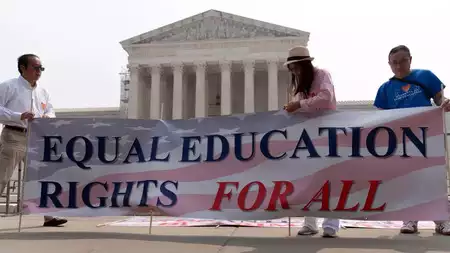In a landmark decision, the United States Supreme Court has ruled to ban the use of race as a factor in university admissions. The ruling has significant implications for the nation’s educational institutions and has sparked intense debate regarding affirmative action policies. The decision, which aims to promote equal treatment and opportunity for all applicants, has been praised by proponents of merit-based admissions while drawing criticism from those concerned about the potential impact on diversity and representation.
The case before the Supreme Court involved a lawsuit filed by a group of Asian American students against Harvard University, alleging that the university’s admissions policies discriminated against them based on their race. The plaintiffs argued that the use of race as a factor in admissions decisions violated their constitutional rights and perpetuated racial stereotypes. The Court’s ruling, with a majority opinion of 5-4, determined that Harvard’s admissions process did indeed impose a burden on applicants of certain races and failed to meet the strict scrutiny required for such policies.
Supporters of the ban argue that a race-blind approach to admissions is necessary to ensure fairness and equal opportunity for all students. They contend that affirmative action policies, which consider an applicant’s race as a factor in admissions, can result in reverse discrimination and create a system where certain individuals are given preferential treatment based on their race rather than their qualifications. Proponents of merit-based admissions assert that universities should focus on evaluating applicants based on their academic achievements, extracurricular activities, and personal characteristics, rather than their racial or ethnic background.
On the other hand, critics of the ban express concerns about the potential consequences on diversity and representation in higher education. They argue that race-conscious admissions policies are essential for promoting diversity on college campuses and providing opportunities for historically underrepresented groups. These policies aim to address the historical and ongoing disparities faced by marginalized communities and ensure that universities reflect the broader society. Critics worry that the ban could lead to a less diverse student body and hinder efforts to achieve a more inclusive educational environment.
The Supreme Court’s decision has sparked a broader conversation about affirmative action policies and their role in addressing systemic inequalities. While the ruling bans the use of race as a factor in university admissions, it does not completely eliminate the consideration of diversity in admissions decisions. Universities are still allowed to consider race-neutral alternatives to promote diversity, such as socioeconomic status or neighborhood characteristics. However, the ruling makes it clear that any consideration of race must be narrowly tailored and meet strict scrutiny standards.
The implications of this decision extend beyond university admissions and touch on broader societal issues of equality and fairness. It underscores the ongoing debate about how to best address historical and systemic inequities while ensuring equal opportunities for all. The ruling sets a precedent for future cases related to affirmative action and will likely shape admissions policies at universities across the country.
In conclusion, the US Supreme Court’s decision to ban the use of race in university admissions has ignited a contentious debate about affirmative action policies and their impact on equal opportunity and diversity. The ruling aims to promote a race-blind approach to admissions while raising concerns about potential consequences on representation. As universities navigate this new landscape, they will need to carefully evaluate their admissions processes to ensure fairness, diversity, and equal access for all applicants.


